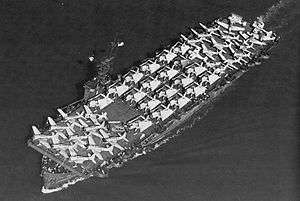USS Liscome Bay (CVE-56)
 | |
| History | |
|---|---|
| Name: | USS Liscome Bay |
| Builder: | Kaiser Shipyards, Vancouver, Washington |
| Laid down: | 9 December 1942 |
| Launched: | 19 April 1943 |
| Commissioned: | 7 August 1943 |
| Fate: | Sunk by Japanese submarine I-175 on 24 November 1943 |
| General characteristics | |
| Class and type: | Casablanca-class escort carrier |
| Displacement: | 7,800 tons (standard), 10,902 tons (full load) |
| Length: | 512 ft 4 in (156.16 m) overall |
| Beam: | 65 ft 3 in (19.89 m), Extreme width: 108 ft 1 in (32.94 m) |
| Draft: | 22 ft 6 in (6.86 m) |
| Propulsion: |
|
| Speed: | 20 knots (37 km/h) |
| Range: | 10,240 nmi (18,960 km) @ 15 kn (28 km/h) |
| Complement: |
|
| Armament: | 1 × 5 in (127 mm)/38 cal dual purpose gun, 16 × Bofors 40 mm guns (8×2), 20 × Oerlikon 20 mm cannons (20×1) |
| Aircraft carried: | 28 |
| Service record | |
| Part of: | United States Pacific Fleet (1943) |
| Commanders: | Captain I.D. Wiltsie |
| Operations: | Gilbert and Marshall Islands campaign |
USS Liscome Bay (CVE-56), a Casablanca-class escort carrier during World War II, was the only ship of the United States Navy to be named for Liscome Bay in Dall Island in the Alexander Archipelago of Alaska. She was lost to a submarine attack during Operation Galvanic, with a catastrophic loss of life, on 24 November 1943.
Her keel was laid down on 9 December 1942 by the Kaiser Shipbuilding Company of Vancouver, Washington, under a United States Maritime Commission contract.
She was originally to have been given to the Royal Navy under the terms of Lend-Lease as HMS Ameer, but was appropriated by the U.S. Navy while still being built.
She was launched on 19 April 1943 sponsored by Mrs. Ben Moreell, wife of the Chief of the Navy's Bureau of Yards & Docks. She was named Liscome Bay on 28 June 1943 and assigned the hull classification symbol CVE-56 on 15 July 1943. She was acquired by the Navy and commissioned on 7 August 1943, Captain Irving D. Wiltsie in command.
Service history
Operation Galvanic
After training operations along the West Coast, the Liscome Bay departed from San Diego, California, on 21 October 1943, arriving at Pearl Harbor one week later. Once additional drills and operational exercises were completed, the escort carrier set off on what was to be her first and last battle mission. As a member of Carrier Division 24 (CarDiv 24), she departed from Pearl Harbor on 10 November attached to TF 52, Northern Attack Force, under Rear Admiral Richmond K. Turner, bound for the invasion of the Gilbert Islands.
The invasion bombardment announcing the United States's first major thrust into the central Pacific began on 20 November at 05:00. Just 76 hours later, Tarawa Atoll and Makin A were both captured. Liscome Bay's aircraft took part in the 2,278 action sorties by carrier-based planes, which neutralized enemy airbases, supported U.S. Army landings and ground operations in bombing-strafing missions, and intercepted enemy raids. With the islands secured, U.S. naval forces began retiring.
Sinking
On 23 November, the Japanese submarine I-175 arrived off Makin. A temporary task group, built around Rear Admiral Henry M. Mullinnix three escort carriers - Liscome Bay, Coral Sea and Corregidor - was steaming 20 miles southwest of Butaritari Island at 15 knots. At 04:30 on 24 November, reveille was sounded in Liscome Bay. The crew went to routine general quarters at 05:05, when flight crews prepared their planes for dawn launchings.
At about 05:10, a lookout shouted, "Here comes a torpedo!" The torpedo struck abaft the after engine room and detonated the aircraft bomb stockpile, causing a major explosion which engulfed the ship and sent shrapnel flying as far as 5,000 yards. "It didn't look like a ship at all", wrote Lieutenant John C. W. Dix, communications officer on Hoel, "We thought it was an ammunition dump... She just went whoom — an orange ball of flame."[1]

At 05:33, Liscome Bay listed to starboard and then sank, carrying 53 officers and 591 enlisted men – including Admiral Mullinix, Captain Wiltsie, and famous Pearl Harbor hero Ship's Cook Third Class Doris Miller - down with her. Of the 916 crewmen, only 272 were rescued by Morris, Hughes and Hull. The survivors had reached the deck soon after the initial torpedo impact. The bombs in storage exploded minutes later, possibly due to a second torpedo.[2]
Including the sailors lost on the Liscome Bay, American casualties in the assault on Makin Island exceeded the strength of the entire Japanese garrison. Future legal scholar Robert Keeton, then a Navy lieutenant, survived the attack.
Awards
Liscome Bay received one battle star for her World War II service.
The ship is briefly mentioned in a clandestine diary kept by sailor James Fahey during the war. His brother John Fahey was an injured survivor and his ordeal and recovery are described.
See also
References
This article incorporates text from the public domain Dictionary of American Naval Fighting Ships.
- James J. Fahey, Pacific War Diary: 1942 - 1945, The Secret Diary of an American Sailor, New York: Houghton Mifflin, 1991. ISBN 0-395-64022-9
- James L. Noles, Jr., Twenty-Three Minutes to Eternity: The Final Voyage of the Escort Carrier USS Liscome Bay, Tuscaloosa: University of Alabama Press, 2004.
External links
| Wikimedia Commons has media related to USS Liscome Bay (CVE-56). |
Coordinates: 2°34′N 172°30′E / 2.567°N 172.500°E